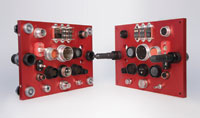
Posted to News on 23rd Nov 2016, 00:00
Fast data acquisition for robots
Cameras and scanners are steadily replacing sensors in many fields of factory automation. Whereas a variety of proximity sensors were previously used to guide a robot arm, for example, that job is now being done by 3D cameras and 3D laser scanners. Selwyn Corns of Multi-Contact outlines what this means for connectors.

A significant change in technology is currently under way in the field of factory automation. Until recently, for the automated fitting of doors onto motor vehicles for example, a variety of sensors were used, such as capacitive and inductive proximity switches for sensing the robot working area. However, this is now being done by 3D cameras and 3D laser scanners.
Robots and assembly technology, combined with image processing, are becoming key technologies in vehicle manufacture. They represent a huge simplification for the assembly and maintenance of production modules, and they simplify material requirements and save space and weight. However, it represents a challenge for the electrical connectors.
Large amounts of data have to be transferred for the evaluation of the camera images and this requires transfer rates of up to 1,000 Mbit/s to do this in real time. This is too fast for the traditional fieldbuses and therefore another well-known transmission standard is being adopted: Ethernet. At the same time, wherever digital image processing has replaced traditional sensors, GigE Vision has established itself as an interface standard, as it enables high bandwidth transmission of large images in real time.
Connector specialist Multi-Contact, has recently developed a new family of Gigabit Ethernet connectors for docking systems, such as those used with robots. These quick-change tool changers are highly accurate connector systems for accurate and safe changing of tools such as welding guns and grippers, and consist of a robot-side multi-coupling half, usually more tool-side multi-coupling halves, and the matching workstations. In addition to automatic tool changers for robots, we also find such docking systems for test facilities for transmission, motor and engine construction.
The GigaDock1 connectors from Multi-Contact are supplied ready for installation on docking plates and tool changer systems. They can easily be connected with an 8-pin M12, Ethernet Cat6a network cable when assembled. Using inexpensive patch cables, distances of up to 100m can be connected. As the connectors are compatible
with the Ethernet standard, users can be ready for future developments. Manfred Müller, product manager for automation at Multi-Contact, commented: “At present, we have a 1Gbit/s transfer rate, with 10Gbit/s in sight. Today doors and tailgates are fitted by robots onto the moving vehicle, with hitherto unparalleled accuracy and repeatability. The result is easy to see, with the joins perfectly aligned. Intelligent image processing makes this possible. Wheel assembly is also carried out on the moving vehicle, with 3D laser scanners showing the assembly robot the correct path.”
With the introduction of image processing on the factory floor, wiring systems and connectors are needed that guarantee trouble-free operation even in the harshest industrial environment. This mainly relates to EMC, but also mechanical stress such as shock and vibration. GigaDock1 connectors are based on proven MULTILAM technology and easily meet these demanding requirements.
In parallel with image processing, a further trend is taking place towards rapidly changing flexible production involving smaller production runs. The automotive market is the best example of this, with vehicle manufacturers introducing new models onto the market at an ever-increasing rate. One consequence for manufacturers is that more and more models in a previously unprecedented number of variants are being built on a relatively small number of production lines. Therefore, to prevent frequent modification and setup operations from becoming a bottleneck, they need to be as automated as possible.
A production line is simply a chain of many individual production modules. Each module has to be supplied with power and needs to communicate with the production control system as well as each other. So for the modules to be flexibly replaced when a modification is made, the connections have to be detachable. Connectors are the best alternative to fixed connections and considerably shorten set-up times.
Depending on the assembly task, the robots need to fetch the tools they require from a docking station. Connectors in a floating configuration are needed here, so that, for example, misalignment tolerances are compensated for and plugs and sockets can locate themselves automatically.
The docking plates can be individually fitted. In addition to the mechanical connection, modules for data and power can be connected at the same time. Depending on the application, units with fluid coupling (water, hydraulic fluid, air), data (fibre optic, data bus) and electrical power connectors can be fitted. Multi-Contact has sophisticated connector solutions for all media types, including its new GigaDock1. Like the other systems for power and data transfer, they operate smoothly and reliably for thousands of mating operations.









